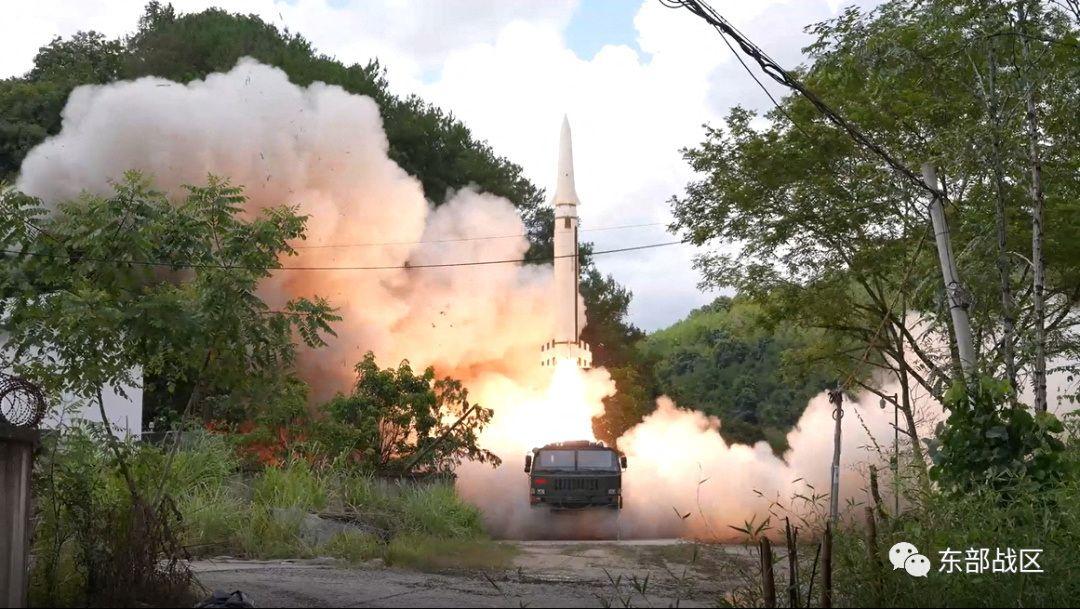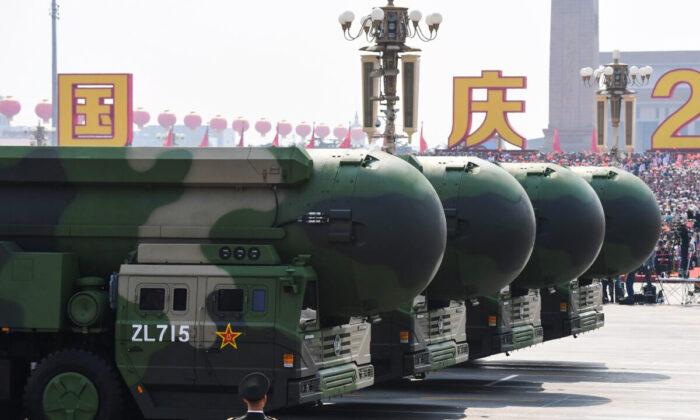Buried in the vast deserts of western China, there are hundreds of new missile silos slated to hold deadly payloads. Some of them will house conventional weapons, others nuclear, and Western leaders don’t know which is which.
Or, in their terms, “multipolarity.”
China’s nuclear expansion, combined with its de facto alliance with Russia, will have far-reaching consequences for U.S. nuclear strategy, and the United States isn’t prepared for the change, According to several experts.
That’s because the U.S. nuclear arsenal and strategy have only ever been designed to contend with one adversary: Russia. The extension of the nuclear threat to several unique actors is therefore one of the great strategic challenges of the 21st century, and one the United States will only get one chance for a response.
“The United States certainly faces a significant challenge ahead as nuclear threats from not just one, but several actors, advance,” Patty-Jane Geller, a senior policy analyst at The Heritage Foundation, a conservative think tank, said in an email.
“It will need to ensure it has tailored deterrence strategies against each adversary, and find the most efficient way to develop a nuclear posture that can address multiple threats at once.”

Axis and Allies
China’s communist leadership is increasing its ties with nuclear Russia and working closely with nuclear aspirants such as Iran and North Korea. Those relationships are increasingly tinted with an explicitly anti-U.S. ideological backing.The language of that effort is important insofar as it builds directly on vocabulary that Putin has spent using to explicitly call for the ending of the United States’ position as world leader.
“This is the beginning of the transition from liberal-globalist American egocentrism to a truly multipolar world.”
That’s changing, however, and now, U.S. military leadership fears that the alliance might not only be real, but extend even to nuclear strategic cooperation.
As it turns out, when nuclear weapons are on the line and hostile regimes are champing at the bit to undermine U.S. interests globally, the fragility of the China-Russia alliance is a secondary issue to the damage it could cause.
Speaking on the issue at a webinar in March, Atlantic Council senior fellow Sarah Kirchberger compared the Sino–Russian alliance to that of Hitler and Stalin in World War II.
“Because, if you look historically [at] how authoritarian countries have acted in unison, sometimes these alliances were very short term and ended abruptly, but they often caused great havoc.”
Nuclear Multipolarity Is Imminent
For Geller, the most pressing issue of this new multipolarity is that U.S. nuclear arsenal and posture is only designed to contend with Russia, not China, much less both simultaneously.“U.S. nuclear posture is currently sized to face only one peer nuclear threat (Russia), as it was designed about a decade ago based on assumptions of a more benign threat environment than we are facing today,” Geller said.
“With the emergence of China as a second nuclear peer, the United States needs a new strategy that can deter both countries at once, which it will not be able to do sufficiently in the future with the current strategy and force posture.”
Indeed, U.S. military leadership hasn’t shied away from that it isn’t prepared to simultaneously face down both China and Russia as nuclear powers, as it has never faced such a situation in history.
“We have no history of this,” he added. “This is epic.”

Multipolarity by the Numbers
Russia has the world’s largest nuclear arsenal, with around 1,500 deployed nuclear weapons and more than 6,000 warheads in total. The United States, meanwhile, has about 1,400 deployed systems and 5,550 warheads. Between 1,500-2,000 warheads in both nations’ arsenals are retired and awaiting disarmament.
There are several reasons for this disparity. One is the extent of the thousands of miles of underground tunnels that the CCP is constructing to tend to its silos, which appears to suggest a far greater operation than previously expected.
Another is the regime’s focus on nuclear missiles that use multiple independently targetable reentry vehicles (MIRVs).
MIRVs are missile payloads that feature several warheads, each of which can be launched independently at separate targets, increasing the lethality of an individual missile many times over.
China’s DF-41 missiles, which the regime’s new silos appear constructed to house, feature a MIRV that can hold up to 10 nuclear warheads.
China’s ‘Nuclear Breakout’ Will Spill Over
Adm. Charles Richard, commander of the U.S. Strategic Command, described that turn of events as China’s “nuclear breakout,” an unprecedented expansion of nuclear forces that should be of significant concern to the United States.China’s growing power not only applies a new pressure point on U.S. strategic thinking, however. It also threatens to give rise to a host of potential conflicts throughout Asia.
“China’s growing nuclear arsenal will enable it to backstop its conventional aggression in the Indo-Pacific region,” she said. “With the backing of a stronger nuclear force, China can calculate that more aggressive actions or escalating in conventional conflicts will be less risky.”
“China’s nuclear expansion will also hinder U.S. extended deterrence efforts as allies in the region become more threatened.”
Thus, governments like those in Taiwan or Japan, or even India, will fall more prone to being targeted by CCP aggression, as the regime will consider the United States less likely to be willing to risk conflict with a strong nuclear power.
This problem is commonly referred to in international relations theory as the “stability-instability paradox.”
In essence, the paradox maintains that two nations with similar nuclear capabilities will deter one another from engaging in nuclear war for fear of mutually assured destruction, which creates stability.
The knowledge that neither side will use its nuclear weapons, however, increases the likelihood that the nations will pursue conventional warfare and indirect conflict, thus creating instability.
As such, Geller believes that a vital component of U.S. nuclear strategy ought to be avoiding a situation in which China’s nuclear power becomes so great that the regime believes it can prevent the United States from interfering in any conflict it may start.
“The most serious concern I believe is less so that we are at risk of China or Russia using nuclear weapons against the U.S.,” Geller said, “but that the U.S. will ultimately back down in a conflict if it does not have a credible nuclear posture and strategy.”
“To prevent this from occurring, the U.S. needs to get serious about reorienting its nuclear posture to deter two nuclear peers, and realize that business as usual will not suffice.”

China Could Coerce the United States
To some extent, some argue that China’s nuclear coercion of the United States has already begun.James Fanell, the former director of Intelligence and Information Operations for the U.S. Pacific Fleet, said that the episode was only the beginning of the CCP’s efforts to direct U.S. behavior.
“[China’s] new nuclear arsenal provides the CCP with the same ability to blackmail the United States from taking more forceful measures to defend our allies as we have seen Vladimir Putin do to the Biden administration in the Ukraine,” Fanell said in an email.
“Even in lesser cases, [China] could further use their nuclear weapons to force America and its allies to alter their behavior.”
Moreover, he said, with each successful attempt to browbeat the United States into demurring, the likelihood that the CCP will turn to intimidation as a preferred diplomatic tactic will increase.
“These nuclear weapons will be used to threaten any nation, like the United States, from coming to Taiwan’s defense in the increasingly likely event Beijing decides to conduct a conventional invasion of Taiwan,” Fanell said.
He added that the CCP would likely use its arsenal to command the ongoings of the Indo-Pacific region.
By threatening the United States with nuclear fire, the CCP could coerce it away from placing new weapons systems in Korea or Japan, or even from entering the Taiwan Strait or the first island chain, which is the first ring of archipelagos east of the Asian coastline. Such an effort could effectively halt the United States’ 187-year history of conducting freedom of navigation operations in the Indo-Pacific.
“It is not hard to imagine this kind of blackmail being used by the CCP to stop diplomatic efforts such as the AUKUS or the Quad agreements,” Fanell said, referring to two partnerships involving the United States and allies in the Indo-Pacific region.
To that end, he described China’s nuclear breakout as “the single biggest factor for destabilizing the international order since the Soviet Union began building its own nuclear arsenal in the 1950s.” And added that the regime was posturing in a similar manner to the Soviet Union, seeking to leverage its nuclear weapons to “blackmail the world to bend to its demands.”
Speaking on the same issue, Geller said that the United States would need to expand its nuclear capabilities to prevent China’s regional nuclear advantage from growing any further.
“The goal of the U.S. should be to show China that attempts to coerce the U.S. using nuclear threats will fail because the U.S. has the capability and will to respond to any first use of nuclear weapons,” Geller said.
Tactical Nuclear Weapons Needed
In contemplating what was necessary to restore a credible U.S. nuclear deterrent in a multipolar world, both Fanell and Geller came to the same conclusion: adapt or die.“Given the dramatic change in the status quo … in the Pacific, the United States’ number one priority must be in the rapid fielding of a credible and robust nuclear arsenal,” Fanell said.
“In response to this new reality, the United States must dust off its previously learned policies and postures from the Cold War with the Soviet Union,” Fanell said.
Fanell added that the United States needed to expand its arsenal of strategic nuclear weapons across the triad of land, sea, and, air capabilities, and also to invest large sums into the fielding of tactical nuclear weapons to be positioned in Japan, Korea, and even Taiwan.
Perhaps no capability was more vital to this effort, he said, than the sea-launched nuclear cruise missile (SLCM-N).
“One of these areas [of needed capabilities] regards the fielding of afloat nuclear naval weapons, like the SLCM-N, which the U.S. Navy has unwisely cut research and development funding and for which the Biden Administration remains positioned to eliminate,” Fanell said.
“Instead of killing this program, the current administration should be seeking to enhance the speed with which the SLCM-N is fielded, but should also be looking for other ways to modernize and increase America’s nuclear arsenal.”
Geller agreed, adding that the United States would need to demonstrate both the capability and the will to field nuclear weapons in order to deter China—something that the administration appeared hesitant to do.
“Fielding weapons like the SLCM-N can help show China that the U.S. has a proportional, credible option at this lower level of the escalation ladder,” Geller said.
“The U.S. also needs to demonstrate the will to show strength when needed. Postponing a routine missile test in the face of Chinese aggression toward Taiwan, as one example, only hindered this effort.”
With the international order itself hanging in the balance, Fanell said that the United States’ national security efforts had already been hampered by the burgeoning multipolar order led by China and Russia.
Now, he said, that security needs to be restored. It’s a feat possible only through the forward deployment of new, tactical nuclear weapons.
“These may seem like provocative measures,” Fanell said, “but when measured against the backdrop of [China’s] nuclear breakout this past 20 months, and Vladimir Putin’s nuclear blackmail over Ukraine, the U.S. does not have a moment to lose in restoring national security.”
White House and Pentagon officials didn’t respond by press time to a request by The Epoch Times for comment.





